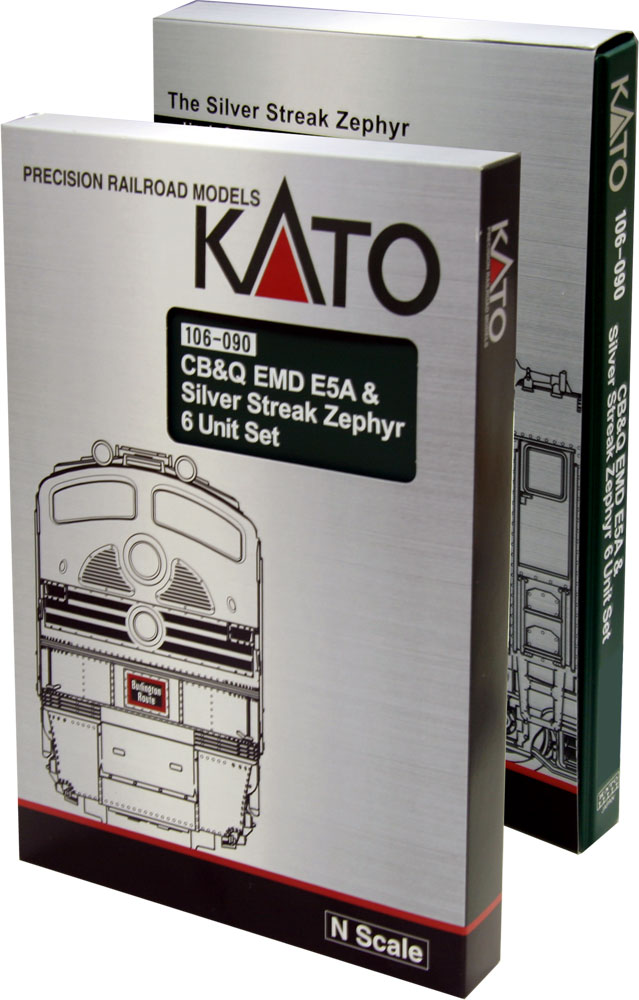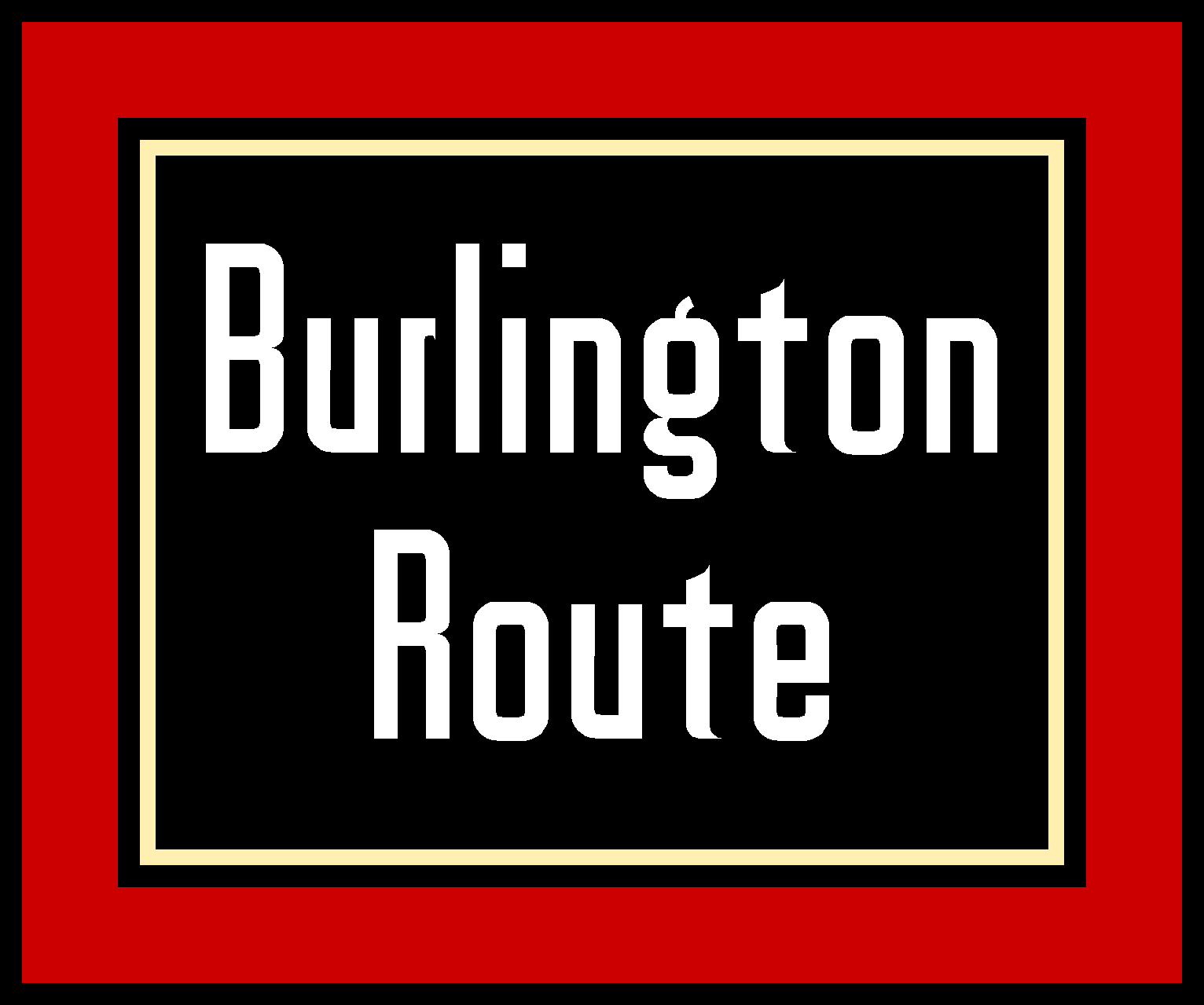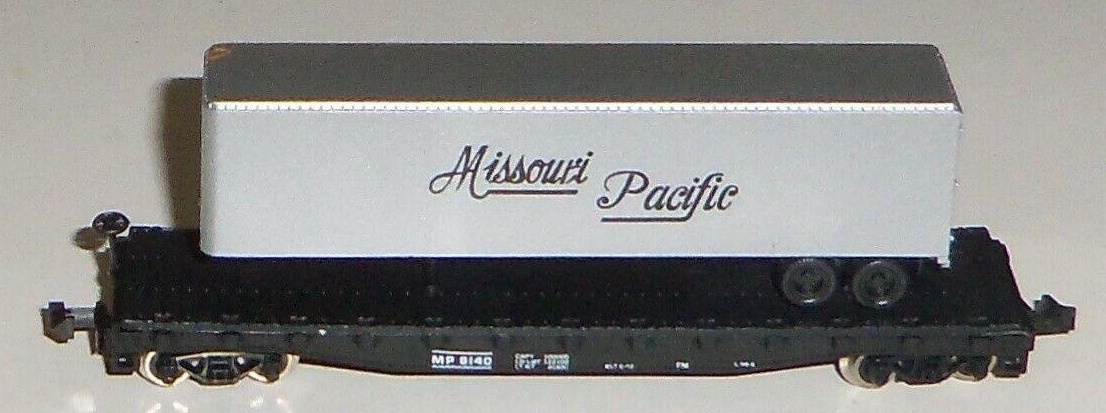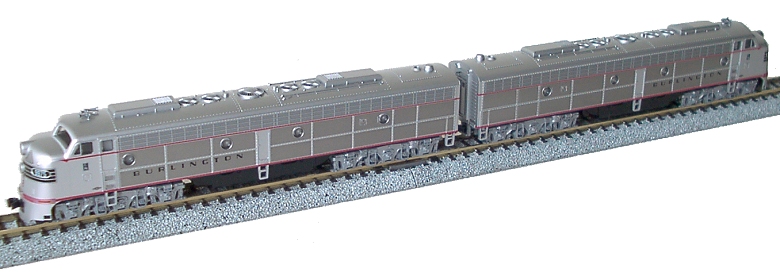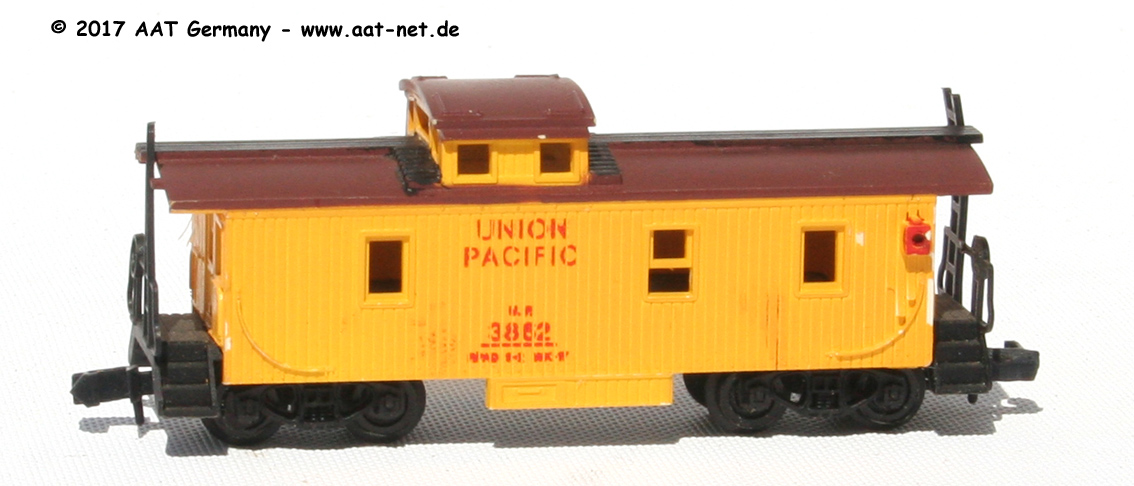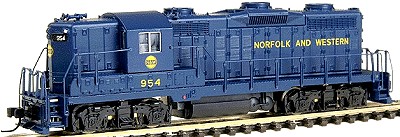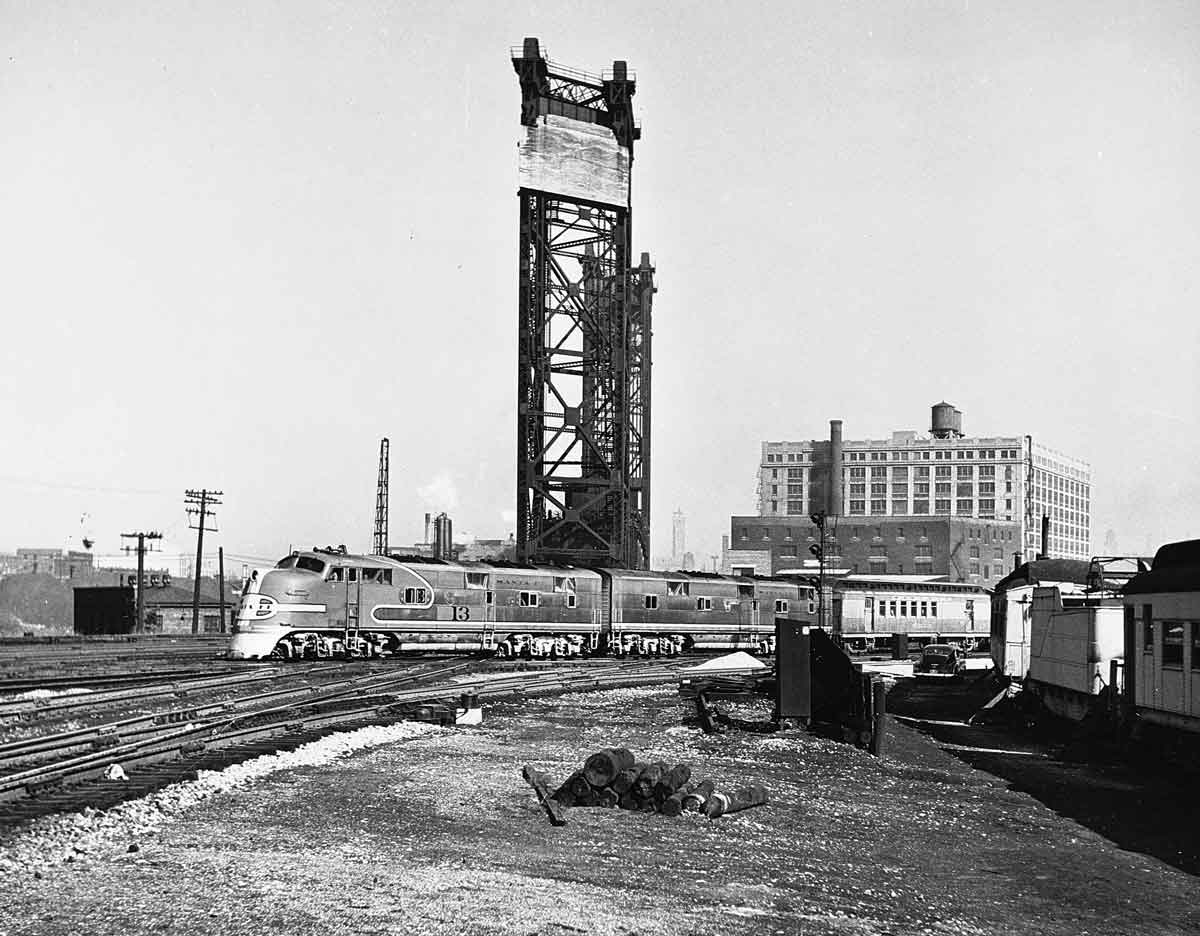Specific Item Information: To call the "Silver Streak Zephyr" famous before its time would be to do the all-corrugated, slick stainless steel train a disservice. Named after a movie of the same name which featured the CB&Q's distinctive corrugated equipment, the "Silver Streak Zephyr" and its specially built EMD E5A unit "Silver Bullet" was a short distance luxury train that operated between Lincoln, Nebraska and Kansas City with stops in Omaha and St. Joseph.
Like the train it pulled, the EMD E5A was a unique piece of equipment - specially built just for the CB&Q so that they could have a locomotive which matched their Budd built corrugated cars, the EMD E5A was wrapped in shining stainless steel and ribbed with corrugated fluting that gave the CB&Q's trains an unmatched streamlined look.
Features: Locomotive: Equipped with a mix of body and truck mounted KATO magnetic knuckle couplers Locomotive: Directional Golden White LED headlights and illuminated preprinted numberboards Locomotive: DDC Decoder Equipped Cars: Smooth rolling blackened metal wheels with all-wheel electrical pickup Cars: Ability to be lit with optional 11-211/212 Version 2 LED Interior lighting kits Cars: Illuminated marker lights on tail car
EMD E5A #9909 “Silver Bullet” with Skirted Trucks and "Silver Streak Zephyr" lettering
Budd Baggage/RPO #1600 “Silver Sheen”
Budd Baggage Car #900 “Silver Light”
Budd Coach #4703 “Silver Gleam”
Budd Coach #4704 “Silver Glow”
Budd Observation #300 “Silver Spirit”
Like the train it pulled, the EMD E5A was a unique piece of equipment - specially built just for the CB&Q so that they could have a locomotive which matched their Budd built corrugated cars, the EMD E5A was wrapped in shining stainless steel and ribbed with corrugated fluting that gave the CB&Q's trains an unmatched streamlined look.
Features: Locomotive: Equipped with a mix of body and truck mounted KATO magnetic knuckle couplers Locomotive: Directional Golden White LED headlights and illuminated preprinted numberboards Locomotive: DDC Decoder Equipped Cars: Smooth rolling blackened metal wheels with all-wheel electrical pickup Cars: Ability to be lit with optional 11-211/212 Version 2 LED Interior lighting kits Cars: Illuminated marker lights on tail car
EMD E5A #9909 “Silver Bullet” with Skirted Trucks and "Silver Streak Zephyr" lettering
Budd Baggage/RPO #1600 “Silver Sheen”
Budd Baggage Car #900 “Silver Light”
Budd Coach #4703 “Silver Gleam”
Budd Coach #4704 “Silver Glow”
Budd Observation #300 “Silver Spirit”
Model Information: Kato boxed sets for North American Prototypes come in various shapes and sizes. These may contain complete train sets with locomotive, track and power pack or may be as simple as a pair of passenger coaches. Many of the sets use "bookshelf" boxes with cardboard sleeves and carefully cut foam inserts.
Prototype History: The transition era (1939 - 1957) was the heyday for passenger rail. The industrial boom triggered by the second world war created tremendous capacity for production which was no longer needed for war production. The North American factories turned to consumer goods and services and the rail system was a major recipient of this ouput.
The interstate highways system as we know it now was still a thing of the future and long distance travel by highway was simply not practical and aircraft travel was still a luxury for the well-to-do. People traveled the country by rail and there was a huge variety of railroads and services available to the traveler. Innovation was constant, and the materials and machinery employed by the railroads was evolving as fast as the engineers could think of new things to entice the fickle consumer to ride a particular route or particular service.
This all came to an end when the automobile and airplane replaced the passenger train as the preferred vehicles of transportation in the 1960s.
The interstate highways system as we know it now was still a thing of the future and long distance travel by highway was simply not practical and aircraft travel was still a luxury for the well-to-do. People traveled the country by rail and there was a huge variety of railroads and services available to the traveler. Innovation was constant, and the materials and machinery employed by the railroads was evolving as fast as the engineers could think of new things to entice the fickle consumer to ride a particular route or particular service.
This all came to an end when the automobile and airplane replaced the passenger train as the preferred vehicles of transportation in the 1960s.
Road Name History: The Chicago, Burlington and Quincy Railroad (reporting mark CBQ) was a railroad that operated in the Midwestern United States. Commonly referred to as the Burlington or as the Q, the Burlington Route served a large area, including extensive trackage in the states of Colorado, Illinois, Iowa, Kentucky, Missouri, Montana, Nebraska, Wisconsin, Wyoming, and also in New Mexico and Texas through subsidiaries Colorado and Southern Railway, Fort Worth and Denver Railway, and Burlington-Rock Island Railroad.[citation needed] Its primary connections included Chicago, Minneapolis-St. Paul, St. Louis, Kansas City and Denver. Because of this extensive trackage in the midwest and mountain states, the railroad used the advertising slogans "Everywhere West", "Way of the Zephyrs", and "The Way West". It merged into Burlington Northern in 1970.
In 1967, it reported 19,565 million net ton-miles of revenue freight and 723 million passenger miles; corresponding totals for C&S were 1,100 and 10 and for FW&D were 1,466 and 13. At the end of the year CB&Q operated 8,538 route-miles, C&S operated 708 and FW&D operated 1362. (These totals may or may not include the former Burlington-Rock Island Railroad.)
Information sourced from Wikipedia
In 1967, it reported 19,565 million net ton-miles of revenue freight and 723 million passenger miles; corresponding totals for C&S were 1,100 and 10 and for FW&D were 1,466 and 13. At the end of the year CB&Q operated 8,538 route-miles, C&S operated 708 and FW&D operated 1362. (These totals may or may not include the former Burlington-Rock Island Railroad.)
Information sourced from Wikipedia
Brand/Importer Information: KATO U.S.A. was established in 1986, with the first U.S. locomotive model (the GP38-2, in N-Scale) released in 1987. Since that time, KATO has come to be known as one of the leading manufacturers of precision railroad products for the modeling community. KATO's parent company, Sekisui Kinzoku Co., Ltd., is headquartered in Tokyo, Japan.
In addition to producing ready-to-run HO and N scale models that are universally hailed for their high level of detail, craftsmanship and operation, KATO also manufactures UNITRACK. UNITRACK is the finest rail & roadbed modular track system available to modelers today. With the track and roadbed integrated into a single piece, UNITRACK features a nickel-silver rail and a realistic-looking roadbed. Patented UNIJOINERS allow sections to be snapped together quickly and securely, time after time if necessary.
The Kato U.S.A. office and warehouse facility is located in Schaumburg, Illinois, approximately 30 miles northwest of Chicago. All research & development of new North American products is performed here, in addition to the sales and distribution of merchandise to a vast network of wholesale representatives and retail dealers. Models requiring service sent in by hobbyists are usually attended to at this location as well. The manufacturing of all KATO products is performed in Japan.
Supporters of KATO should note that there is currently no showroom or operating exhibit of models at the Schaumburg facility. Furthermore, model parts are the only merchandise sold directly to consumers. (Please view the Parts Catalog of this website for more specific information.)
In addition to producing ready-to-run HO and N scale models that are universally hailed for their high level of detail, craftsmanship and operation, KATO also manufactures UNITRACK. UNITRACK is the finest rail & roadbed modular track system available to modelers today. With the track and roadbed integrated into a single piece, UNITRACK features a nickel-silver rail and a realistic-looking roadbed. Patented UNIJOINERS allow sections to be snapped together quickly and securely, time after time if necessary.
The Kato U.S.A. office and warehouse facility is located in Schaumburg, Illinois, approximately 30 miles northwest of Chicago. All research & development of new North American products is performed here, in addition to the sales and distribution of merchandise to a vast network of wholesale representatives and retail dealers. Models requiring service sent in by hobbyists are usually attended to at this location as well. The manufacturing of all KATO products is performed in Japan.
Supporters of KATO should note that there is currently no showroom or operating exhibit of models at the Schaumburg facility. Furthermore, model parts are the only merchandise sold directly to consumers. (Please view the Parts Catalog of this website for more specific information.)
Item created by: Jenna on 2018-11-13 10:36:06. Last edited by Alain LM on 2023-03-15 10:42:30
If you see errors or missing data in this entry, please feel free to log in and edit it. Anyone with a Gmail account can log in instantly.
If you see errors or missing data in this entry, please feel free to log in and edit it. Anyone with a Gmail account can log in instantly.


